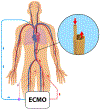A simulation study of left ventricular decompression using a double lumen arterial cannula prototype during a veno-arterial extracorporeal membrane oxygenation
- PMID: 31244372
- PMCID: PMC7076715
- DOI: 10.1177/0391398819858084
A simulation study of left ventricular decompression using a double lumen arterial cannula prototype during a veno-arterial extracorporeal membrane oxygenation
Abstract
Background: Veno-arterial extracorporeal membrane oxygenation can be vital to support patients in severe or rapidly progressing cardiogenic shock. In cases of left ventricular distension, left ventricular decompression during veno-arterial extracorporeal membrane oxygenation may be a crucial factor influencing the patient outcome. Application of a double lumen arterial cannula for a left ventricular unloading is an alternative, straightforward method for left ventricular decompression during extracorporeal membrane oxygenation in a veno-arterial configuration.
Objectives: The purpose of this article is to use a mathematical model of the human adult cardiovascular system to analyze the left ventricular function of a patient in cardiogenic shock supported by veno-arterial extracorporeal membrane oxygenation with and without the application of left ventricular unloading using a novel double lumen arterial cannula.
Methods: A lumped model of cardiovascular system hydraulics has been coupled with models of non-pulsatile veno-arterial extracorporeal membrane oxygenation, a standard venous cannula, and a drainage lumen of a double lumen arterial cannula. Cardiogenic shock has been induced by decreasing left ventricular contractility to 10% of baseline normal value.
Results: The simulation results indicate that applying double lumen arterial cannula during veno-arterial extracorporeal membrane oxygenation is associated with reduction of left ventricular end-systolic volume, end-diastolic volume, end-systolic pressure, and end-diastolic pressure.
Conclusions: A double lumen arterial cannula is a viable alternative less invasive method for left ventricular decompression during veno-arterial extracorporeal membrane oxygenation. However, to allow for satisfactory extracorporeal membrane oxygenation flow, the cannula design has to be revisited.
Keywords: Extracorporeal membrane oxygenation; cannula; circulation; double lumen cannula; model; modelica.
Conflict of interest statement
Declaration of Conflicting Interests
The authors declare no conflicting interests.
Figures






Similar articles
-
Transseptal catheter decompression of the left ventricle during extracorporeal membrane oxygenation.Pediatr Cardiol. 2012 Jan;33(1):185-7. doi: 10.1007/s00246-011-0113-7. Epub 2011 Oct 9. Pediatr Cardiol. 2012. PMID: 21984264
-
Peripheral VA-ECMO with direct biventricular decompression for refractory cardiogenic shock.Perfusion. 2018 Sep;33(6):493-495. doi: 10.1177/0267659118761558. Epub 2018 Feb 21. Perfusion. 2018. PMID: 29466925 Clinical Trial.
-
Percutaneous Decompression of the Left Ventricle in Cardiogenic Shock Patients on Venoarterial Extracorporeal Membrane Oxygenation.J Card Surg. 2016 Mar;31(3):177-82. doi: 10.1111/jocs.12696. Epub 2016 Jan 25. J Card Surg. 2016. PMID: 26809382
-
The hemodynamic effect of different left ventricular unloading techniques during veno-arterial extracorporeal life support: a systematic review and meta-analysis.Perfusion. 2020 Oct;35(7):664-671. doi: 10.1177/0267659119897478. Epub 2020 Jan 17. Perfusion. 2020. PMID: 31948360
-
Left ventricular unloading during veno-arterial ECMO: a review of percutaneous and surgical unloading interventions.Perfusion. 2019 Mar;34(2):98-105. doi: 10.1177/0267659118794112. Epub 2018 Aug 16. Perfusion. 2019. PMID: 30112975 Free PMC article. Review.
Cited by
-
Left ventricular unloading and the role of ECpella.Eur Heart J Suppl. 2021 Mar 27;23(Suppl A):A27-A34. doi: 10.1093/eurheartj/suab006. eCollection 2021 Mar. Eur Heart J Suppl. 2021. PMID: 33815012 Free PMC article.
References
-
- Meani P, Gelsomino S, Natour E, et al. Modalities and Effects of Left Ventricle Unloading on Extracorporeal Life support: a Review of the Current Literature. Eur J Heart Fail 2017; 19 Suppl 2: 84–91. - PubMed
-
- Strunina S, Hozman J, Ostadal P. Relation Between Left Ventricular Unloading During Ecmo And Drainage Catheter Size Assessed By Mathematical Modeling. Acta Polytech Scand Chem Technol Ser 2017; 57: 367.
-
- Truby LK, Takeda K, Mauro C, et al. Incidence and Implications of Left Ventricular Distention During Venoarterial Extracorporeal Membrane Oxygenation Support. ASAIO J 2017; 63: 257–265. - PubMed
MeSH terms
Grants and funding
LinkOut - more resources
Full Text Sources

